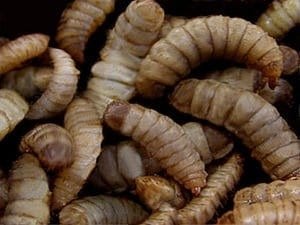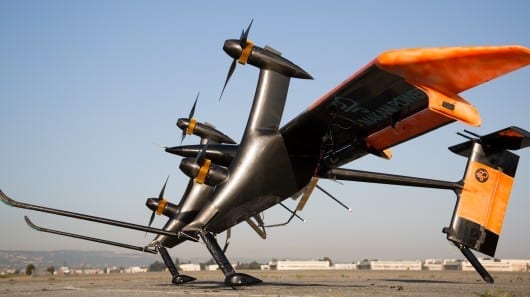
Attention, steak eaters: We are nearing a livestock crisis.
With the planet expected to add another 2 billion people by 2050, it will be more difficult and more expensive than ever to keep eating poultry, fish, and beef at nearly every meal.
To meet global demand, the food industry could crank up the factory-food production model, but, as Arnold van Huis, a professor of tropical entomology at Wageningen University and Research Center, warns, “this puts heavy pressure on already limited resources of land, fertilizers and energy, while greenhouse gas emissions, deforestation, and environmental degradation will increase.” And it would do little to keep the cost of chicken, pork, beef, and fish under control.
There is a environmentally friendlier, more economical alternative, although it’s one that is high on the ick factor. We could introduce protein-rich insects into our diets.
Glen Courtright, a systems engineer and entrepreneur, is betting on the bugs. The Yellow Springs (Ohio)-based company he founded, EnviroFlight, has pioneered over the past three years a new bio-conversion facility powered by millions of mating black soldier flies and tens of millions of their wriggly offspring. The business is in the larvae.
“At our plant we can produce a few million black soldier fly eggs daily,” Courtright says. “That’s about 2,000 tons of a formulated animal feed every year.” For years, conservationists have been keen to exploit the voracious appetite of the black soldier fly (Hermetia illucens) to speed up composting of food wastes. Anglers know the species for their pupae, which make ideal bait. Chicken and pigs like the fatty, protein-rich larvae, too. EnviroFlight is among the first to industrialize the production of black soldier fly larvae to introduce a sustainable, chemical-free, protein-rich feed source for the food-processing industry. It’s part of a larger movement to tap insects (PDF) as a plentiful, more energy-efficient feed substitute that, it is hoped, could wean the food industry off the use of potentially harmful hormones and antibiotics to increase yields.
The United Nations Food and Agriculture Organization (FAO) recently warned that global food production must increase 60 percent by 2050 to keep up with population growth. “Every 12 days we can produce 225 pounds of clean safe feed ingredients for aquaculture, poultry, and crustacea—that’s the holy trinity of fish, shrimp, and chicken—in a three-foot-by-five-foot space. You can grow the equivalent of one of me every 12 days,” says Courtright.
The Latest Bing News on:
Insects for feed stock
- 9 key considerations when raising insects for feedon May 6, 2024 at 7:04 pm
Raising insects for use in poultry nutrition offers numerous opportunities, but there are important considerations that must be understood to make insect farming a true success.
- Fact Check: Tyson Foods does not put insects into products for human consumptionon May 6, 2024 at 7:57 am
Tyson Foods does not list insects or “bugs” as FDA-approved ingredients in its products, as suggested in posts referencing a partnership with insect-ingredient supplier Protix for material to be used ...
- Spring unleashes its annual pest paradeon May 6, 2024 at 3:22 am
For gaps smaller than half an inch, clean the surface of debris, allow it to dry, and then apply latex caulk or silicone sealant. Don’t seal up drainage points in bricks – products are available that ...
- Ag Report: Protect your garden from insect damageon May 5, 2024 at 12:00 pm
Beware! Your beautiful garden may be facing an unseen invasion. Insects, the tiny foes of greenery, pose a significant threat to our plants, feeding voraciously and leaving ...
- How to 'get outside' during cicada emergenceon May 3, 2024 at 10:00 pm
Generations of children living in the Southeast have long listened to the sound of a cicada’s song and collected their exoskeletons in yards and wooded areas. With the expected emergence ...
- The Rise of Insect-Based Alternatives and the Role of AIon May 2, 2024 at 2:48 pm
AI works substantially faster, drastically reducing the trial-and-error process, an observational step to perfect insect production.
- Edible Insects Market to Reach $17.9 Billion by 2033 - Exclusive Report by Meticulous Research®on May 2, 2024 at 7:36 am
According to a new market research report titled, 'Edible Insects Market by Product (Whole Insect, Insect Powder, Insect Meal, Insect ...
- Insect Farmers Leverage AI to Find the Best Methods for Reducing Spendingon May 1, 2024 at 8:50 pm
Artificial intelligence's latest venture proves to be insect farms as farmers look to utilize the booming technology to study data and recommend the best methods to lower production costs.
- Flies used for feed: French company’s pilot plant grand opening in Decaturon April 29, 2024 at 4:50 pm
Local, state and international representatives marked the grand opening of the North American Insect Innovation Center pilot facility.
- Box Tree Moth quarantine issued for southwest Ohioon April 29, 2024 at 3:42 am
Box tree moths are one of those insects that you'll likely notice in the spring. They are considered an invasive species and originate from Asia.
The Latest Google Headlines on:
Insects for feed stock
[google_news title=”” keyword=”insects for feed stock” num_posts=”10″ blurb_length=”0″ show_thumb=”left”]
The Latest Bing News on:
Black soldier fly eggs
- State accepting challenges fix broadband mapping errorson May 7, 2024 at 8:02 pm
New Mexico has been allocated nearly $700 million to connect unconnected or poorly connected areas in the state to broadband, but to make sure the right households are reaping the benefits of that ...
- Internet Votes for Favorite Beauty Hacks—Experts Share Their Takeson May 7, 2024 at 10:37 am
From DIY body scrubs to tips for curling lashes, we asked experts to give the verdict on these popular budget beauty hacks.
- Full repairs to damaged Red Sea internet cables delayed by Yemen political splitson May 7, 2024 at 9:03 am
The Yemeni government has granted permits for the repair of two out of three cables, but refused the third because of a dispute with one of the cable’s consortium members.
- 5 Ways to Fix the GTA V “Rockstar Game Services are Unavailable” Error on Windows PCson May 7, 2024 at 5:53 am
Here, we look at how you can fix Grand Theft Auto V’s “Rockstar game services are unavailable” error on Windows 11/10 PCs. Are you another player who can’t play GTA V or GTA Online because of that ...
- 9 Fixes for the "No Internet Secured" Error on Windows 10on May 6, 2024 at 3:35 am
Running into the "No Internet, secured" message? Fix this common wireless error with these tips and get back online.
- Give small businesses the ‘right to repair’on May 2, 2024 at 7:00 am
Thankfully, bipartisan members of Congress have introduced a commonsense proposal that would benefit small businesses and consumers: the Right to Equitable and Professional Auto Industry Repair Act.
- How to fix the Longbeard error in Sea of Thieveson May 2, 2024 at 6:56 am
Sea of Thieves the game’s server status Restart your modem and router: This can often fix temporary glitches with your internet connection. Change your DNS servers: Occasionally, using different DNS ...
- How to fix your internet connectionon May 2, 2024 at 1:34 am
The internet is more important than ever because it is our gateway to our daily lives. For example, most school works and jobs require online tools. It is so vital to modern people’s lives that ...
- Chuck Todd: The race to build a better internet — before it's too lateon May 1, 2024 at 2:00 am
Reality check: "Any person in the U.S., regardless of their immigration status, may be entitled to many of the same constitutional rights as U.S. citizens, including the right to due process and equal ...
- 5 Ways to Fix the Failed-to-Connect-to-Server Minecraft Error on Windows PCson April 30, 2024 at 9:25 am
This troubleshooting guide provides some possible resolutions for fixing the Minecraft error message that says, “Failed to connect to the server.” Are you seeking a fix for that server connectivity ...
The Latest Google Headlines on:
Black soldier fly eggs
[google_news title=”” keyword=”black soldier fly eggs” num_posts=”10″ blurb_length=”0″ show_thumb=”left”]










